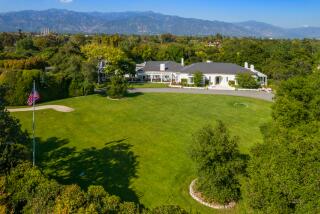The well-tended garden that is San Marino
- Share via
With a multitude of mansions, a median household income of $125,000 and the Huntington Library, Art Collections and Botanical Gardens at its heart, San Marino and money are practically synonymous. But the pristine San Gabriel Valley city of 13,000 also has a strong family emphasis.
Wow factor
The Huntington Library is the centerpiece of San Marino. Once the estate of wealthy railroad magnate Henry Huntington, the grounds cover 207 acres, with 105 acres devoted to gardens. Many residents purchase the institution’s $250 annual “supporting” level membership so they can stroll the grounds from 8 a.m., four hours before the gardens open to the public.
Insider’s view
While the Huntington Gardens are world-renowned, San Marino’s best-kept secret is Lacy Park, a 30-acre green span in the heart of a lush residential area. A walking lane circles the park’s woodsy perimeter. Open to the public during the week, the park requires a weekend admission of $3 for nonresidents.
Drawing card
San Marino appeals to families with children. The schools are top ranking, the crime rate is low and the sense of community is strong.
Good news, bad news
Few cities are as uniform as San Marino. To maintain its “unique residential character,” there are a number of “special ordinances that are peculiar to the city,” according to the “Informational Guide for San Marino Residents,” a 24-page booklet given to new residents.
Mandatory two-car garages must be used to store cars only. Peddlers and the distribution of any handbills are banned. Rubbish must be stored out of sight. Even on trash collection day, you won’t see a trash can in San Marino because trash companies go directly to the backyard for pickup.
The city also has some of the stiffest design guidelines in Southern California.
San Marino city codes have been “strict and unusual” since 1913, according to Paul Crowley of the San Marino Historical Society. “Outlawed were theaters, churches, cemeteries, bowling alleys, secondhand stores, nighttime hours, most signage, overnight street parking, malls, visible rubbish, alcohol and multiunit housing,” he said.
In 1940, the city lifted its ban on churches, and three years ago allowed the sale of wine and beer in restaurants. But the rest of the original prohibitions stand today. “If you’re not sure in San Marino, it’s illegal,” Crowley said.
Hot spots
Mission-style homes on minuscule lots are common in the Mission District. Two popular pockets are on Las Flores and Euclid avenues, just north of Mission Street. The homes, ranging from the high $400,000s to the high $800,000s, are modest by San Marino standards, but many real estate agents have a waiting list of potential customers who wish to buy on these tree-lined streets.
Although neighbors on Las Flores no longer gather at 5 p.m. daily to sweep oak leaves as they did in the 1950s, the sense of community remains. Residents near the Mission Business District can walk to shops or to Julienne, a European-style cafe.
The Oak Grove neighborhood above Lacy Park has San Marino’s greatest concentration of palatial mansions. Two-million dollars might buy a “starter” home in the neighborhood.
Report card
Based on SAT 9 test results, San Marino High School and Huntington Middle School are ranked in the top 1% of California schools, and they are ranked No. 1 in Los Angeles County. The two elementary schools are in the top 10% of L.A. County schools.
On the market
By city ordinance, San Marino has only single-family housing. About 50 homes are on the market, ranging from a 1,400-square-foot home on a small lot on a busy street for $525,000 to a 5,510-square-foot “fixer upper” on nearly an acre in the estate area listed for just under $2.9 million, according to Carol Chua-Vigue of Coldwell Banker in Pasadena.
Historical values
Single-family detached home prices:
Year...Median Price
1990...$682,000
1995...$525,000
2000...$670,000
2001...$681,000
2002*...$782,750
*year to date
Sources: DataQuick Information Services; Carol Chua-Vigue, Coldwell Banker; Paul Crowley, San Marino Historical Society; San Marino City Hall; “City of San Marino Informational Guide for San Marino Residents.”
More to Read
Sign up for Essential California
The most important California stories and recommendations in your inbox every morning.
You may occasionally receive promotional content from the Los Angeles Times.






